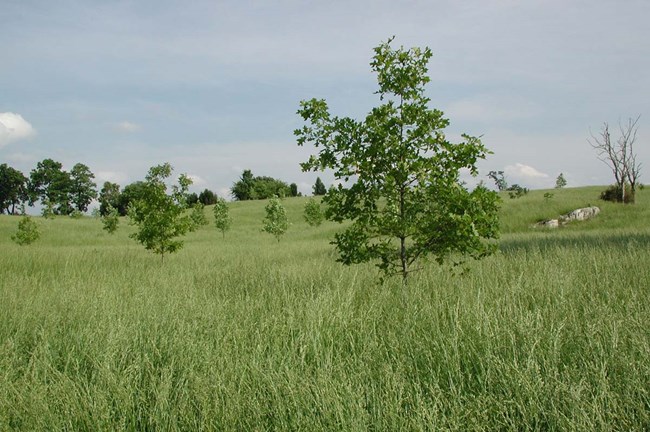Last updated: August 14, 2024
Article
Back to the Future: National Park Service to convert agricultural acres to native grasslands
Projects boost parkland climate resilience, ecological and cultural value

NPS Photo
There’s a century’s old story about a squirrel that could travel from the east coast to the Mississippi River without ever leaving the treetops. If it were true, that would be an amazing squirrel because its journey would have required that it not only cross through forests, but also wetlands and massive areas of open grasslands.
National Park Service ecologist Dr. Dorothy Borowy knows the old myth. “Most people, if they think about grasslands at all, associate them with the tall- and shortgrass prairies of the central U.S.,” she said. “However, few people realize that grasslands once comprised a large portion of the eastern U.S.; historically, various grassland types, including meadows, savannas, woodlands, fens, and glades, were interspersed among forested areas, creating a mosaic of different habitats on the landscape.”
Since European settlement, more than 90 percent of eastern grasslands have been lost to agriculture and human development. What little remains is mostly found on protected public lands and private rights of way.
Today, ecologists use the old squirrel story to expose the inaccuracy of the notion that the eastern U.S. was once covered by dense forests, and to highlight the rich ecological and cultural value of eastern grasslands.
Beyond correction of the record, the National Park Service is today investing funds from the Bipartisan Infrastructure Law to increase these ecological and cultural values in landscape restoration projects in six parks in Virginia, West Virginia, Maryland and western Pennsylvania. “The goal is to restore the ecological integrity of the land by increasing native biodiversity, repairing ecological processes, and enhancing visitor experience in parks,” said Dr. Borowy.
The initial work will focus on converting approximately 400 acres of open lands that have been previously used for agriculture into native grasslands. It will also be closely monitored for tactics that can be applied to additional projects in the next rounds of Infrastructure Law funding.

NPS / Moore
The parks – Antietam National Battlefield, Chesapeake and Ohio Canal National Historical Park, Manassas National Battlefield, Booker T. Washington National Monument, Appalachian National Scenic Trail, and Gettysburg National Military Park – were created to commemorate key points in history and, as a result, must retain their historical character as it existed 100 to 200 years ago.
“These parks have hundreds of acres of open space which over time have become increasingly difficult to maintain,” Dr. Borowy said. “When they became part of the National Park System, leasing the land to farmers for agriculture was a simple way to keep the open, historical character of the parks.”
However, agriculture also has its limitations and adverse impacts, including the use of pesticides and loss of native species. In recent years, many historic battlefield parks have become more invested in the idea of converting their open lands and agricultural fields into native grasslands.
In addition to maintaining the historic character of the area, native grasslands also restore ecological value by increasing and conserving native biodiversity and enhancing climate resiliency. Across the eastern U.S., grassland-obligate species (i.e., those species that require grasslands for survival) are among the most rapidly declining group. This includes numerous plants, insects and pollinators, such as the monarch butterfly, bats, grassland birds, small mammals, reptiles, and amphibians.
The initial steps of the projects supported by the infrastructure law are to evaluate each of the six parks and identify actions needed to remove invasive plant species and prepare the sites for native grasslands restoration. Non-native and invasive species will be removed through manual methods like mowing, tilling and targeted applications of herbicides.

NPS Photo
“We need to get these parcels down to zero – no weeds or invasive plant species, nothing,” said Dr. Borowy. “Then we rebuild with a custom seed mixture for each park comprised of a diverse mix of native grass and forb species that are adapted to local conditions and can withstand future climate conditions, followed by prescribed management that reintroduces disturbance via fire and mowing onto the landscape, which is required for maintaining the grassland ecosystems.”
Ecosystem restoration is key to meeting the National Park Service mission to conserve natural and cultural resources and for the enjoyment, education, and inspiration of this and future generations.
Lori Makarick, Ecosystem Restoration Coordinator for the National Park Service said, “These grassland restoration efforts are refining techniques that will be used in other parks as we continue to work with partners to move the needle on restoration of biological diversity in parks. Healthy ecosystems benefit people, animals, plants, and their shared environment which includes parks. Healthy ecosystems bolster our ability to mitigate and adapt to the effects of our changing climate.”
Tags
- antietam national battlefield
- appalachian national scenic trail
- booker t washington national monument
- chesapeake & ohio canal national historical park
- gettysburg national military park
- manassas national battlefield park
- bipartisan infrastructure law
- ecosystems
- ecosystem restoration
- inflation reduction act
- cultural resources
